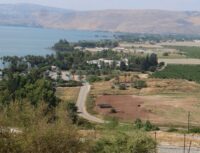 The excavation of the caliph’s palace of Khirbat al-Minya, built on the shore of the Sea of Galilee in the 8th century, has unearthed an ancient mosaic with Nilotic scenes of animal and plants that predates the construction of the palace. Archaeologists from Johannes Gutenberg University Mainz (JGU) conducted geomagnetic surface surveys of the site and dug test pits wherever the results indicated the presence of construction work like walls and flooring lurking under the soil. The test pits proved the effectiveness of the magnetometry findings as the team encountered basalt structures with plastered walls and mosaic floors.
The excavation of the caliph’s palace of Khirbat al-Minya, built on the shore of the Sea of Galilee in the 8th century, has unearthed an ancient mosaic with Nilotic scenes of animal and plants that predates the construction of the palace. Archaeologists from Johannes Gutenberg University Mainz (JGU) conducted geomagnetic surface surveys of the site and dug test pits wherever the results indicated the presence of construction work like walls and flooring lurking under the soil. The test pits proved the effectiveness of the magnetometry findings as the team encountered basalt structures with plastered walls and mosaic floors.
The plants portrayed in one of the mosaics are particularly remarkable as they have the long, curved stems typical of those also depicted in so-called Nile-scene mosaics created in the 5th to 6th centuries. The mosaic’s images of the flora and fauna native to the Nile valley symbolized the life-giving power of the mighty river with its annual floods guaranteeing Egypt’s agricultural fertility. That explains why both late-antique churches, such as that in the nearby Church of the Multiplication in Tabgha, and luxurious dwellings in cities of late antiquity were decorated with Nile-scene mosaics.
The recently discovered mosaic, together with related ceramic finds dating to the 5th to 7th centuries, show that the settlement on the shores of the lake was already thriving centuries before the work on the caliph’s palace had commenced. Its original inhabitants were either Christians or Jews and they were subsequently joined by a small Islamic community, for whom the caliph had a side entrance constructed in the early 8th century so that they could access his palace mosque. The unearthed ceramics have revealed that the site remained occupied under the control of the Umayyad and then Abbasid caliphates from the 7th to the 11th century. New construction projects were initiated in this period during which parts of the mosaics fell victim to pickaxes wielded by religiously inspired iconoclasts, sections of old walls were demolished, and the stones were transported away for reuse elsewhere. The remains finally became the location of a graveyard in which the dead were buried, in accordance with Muslim custom, lying on their side with their faces directed towards Mecca.
 The combination of geomagnetic surveys and targeted excavation allowed archaeologists to make direct hits instead of having to cover a lot of ground in limited time. The magnetic probes track minute changes in the earth’s magnetic field caused by any interference under the surface. Archaeological remains — walls, floors, fireplaces, hearths, ovens — can be mapped with accuracy before the first shovel breaks ground.
The combination of geomagnetic surveys and targeted excavation allowed archaeologists to make direct hits instead of having to cover a lot of ground in limited time. The magnetic probes track minute changes in the earth’s magnetic field caused by any interference under the surface. Archaeological remains — walls, floors, fireplaces, hearths, ovens — can be mapped with accuracy before the first shovel breaks ground.